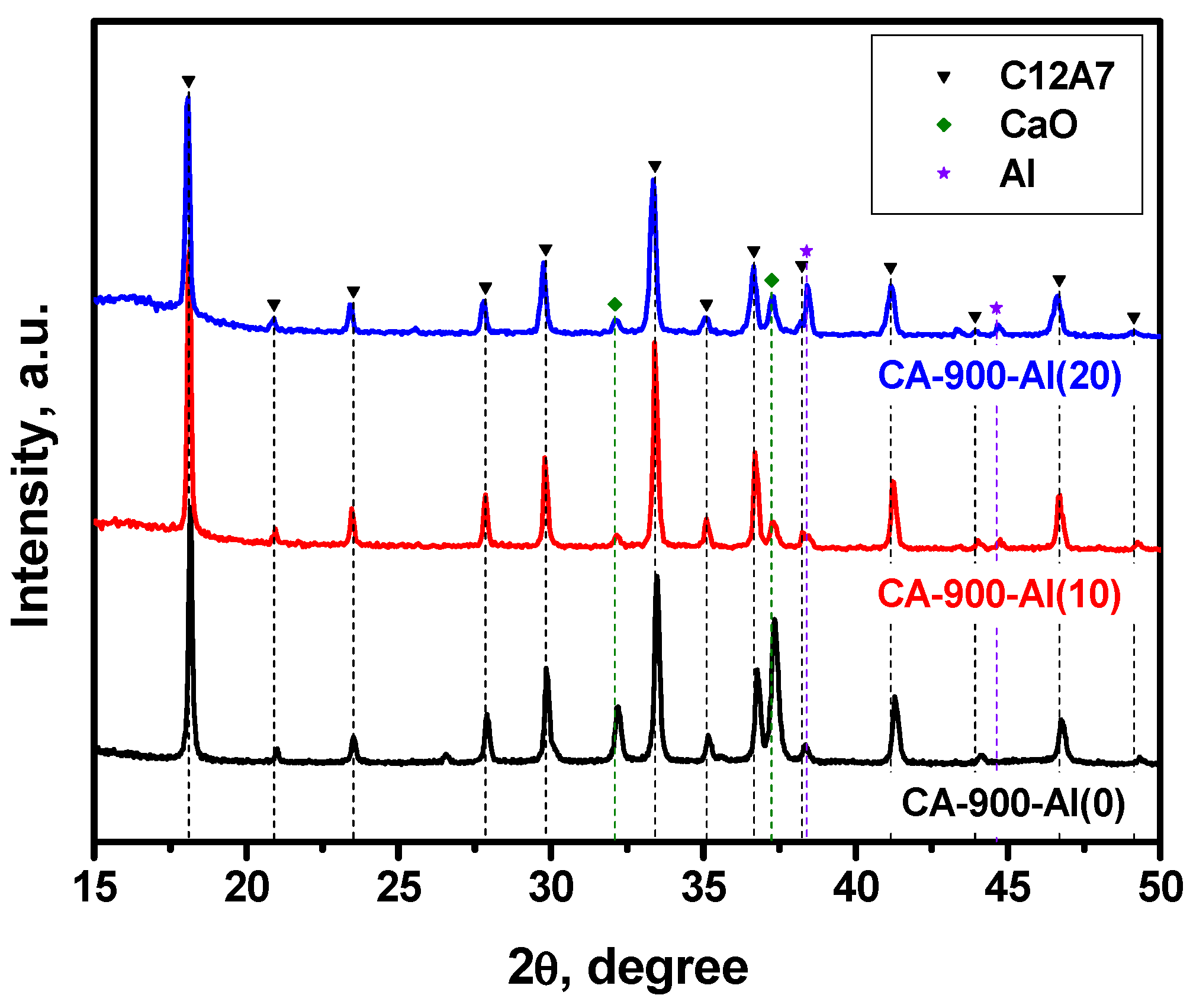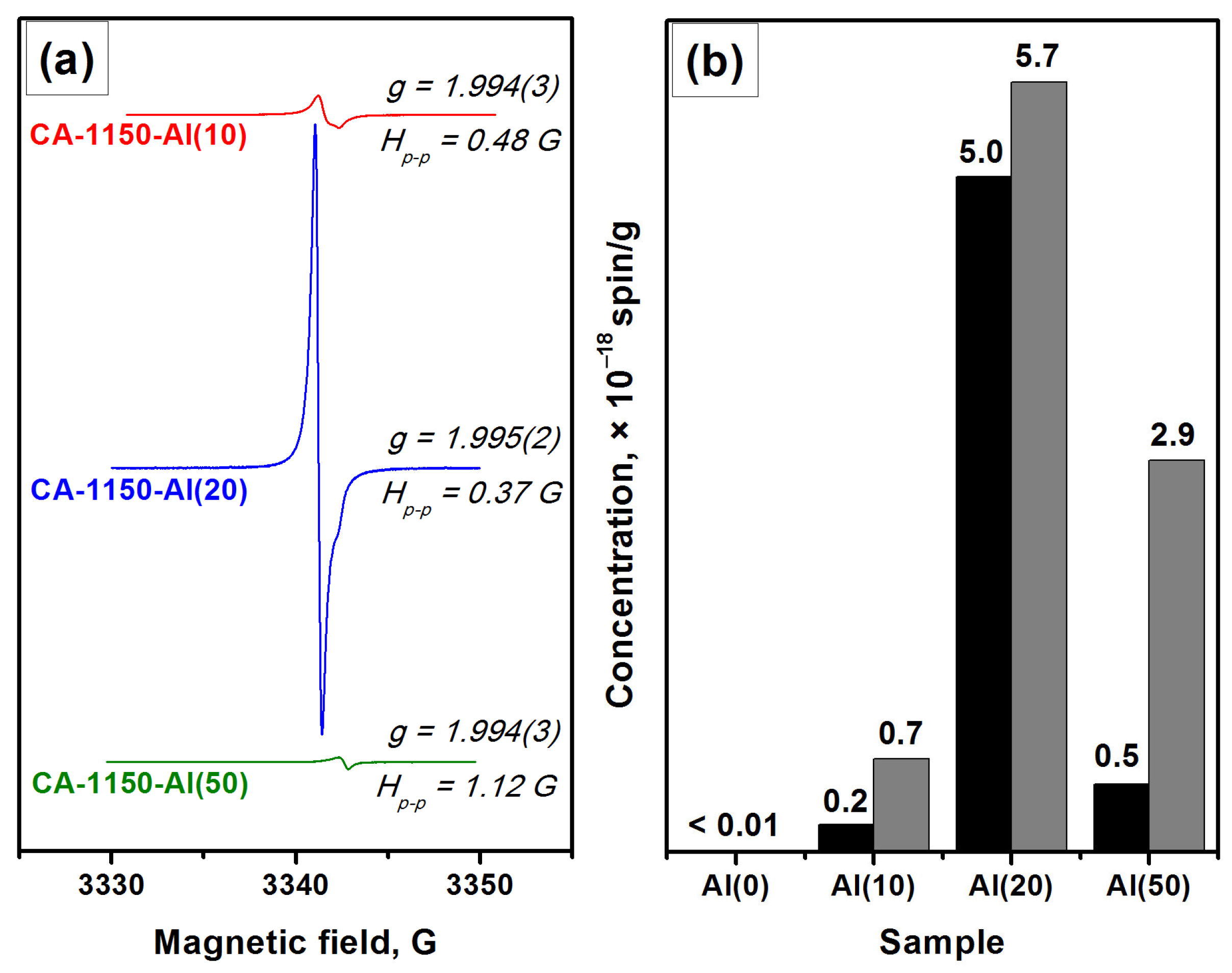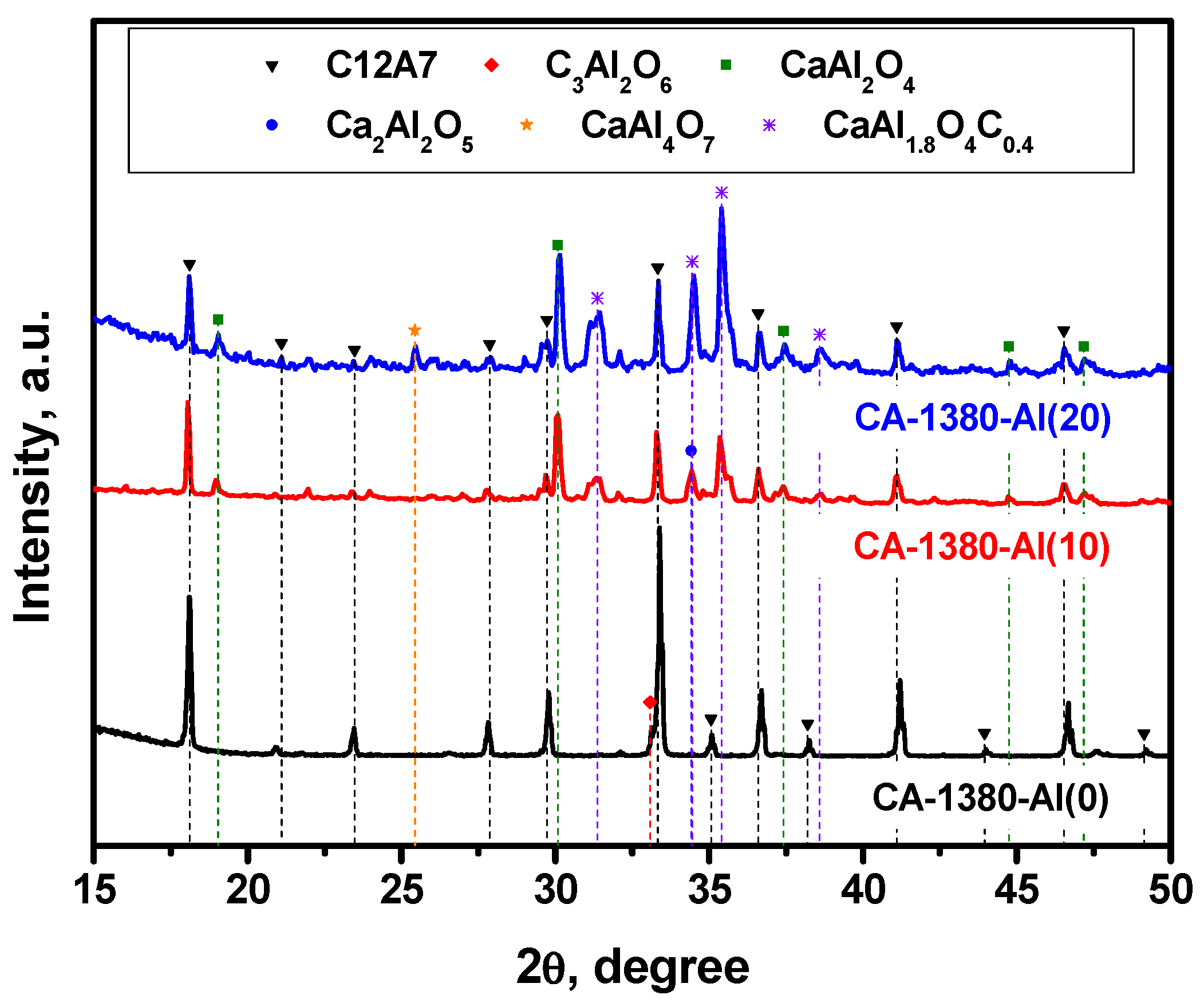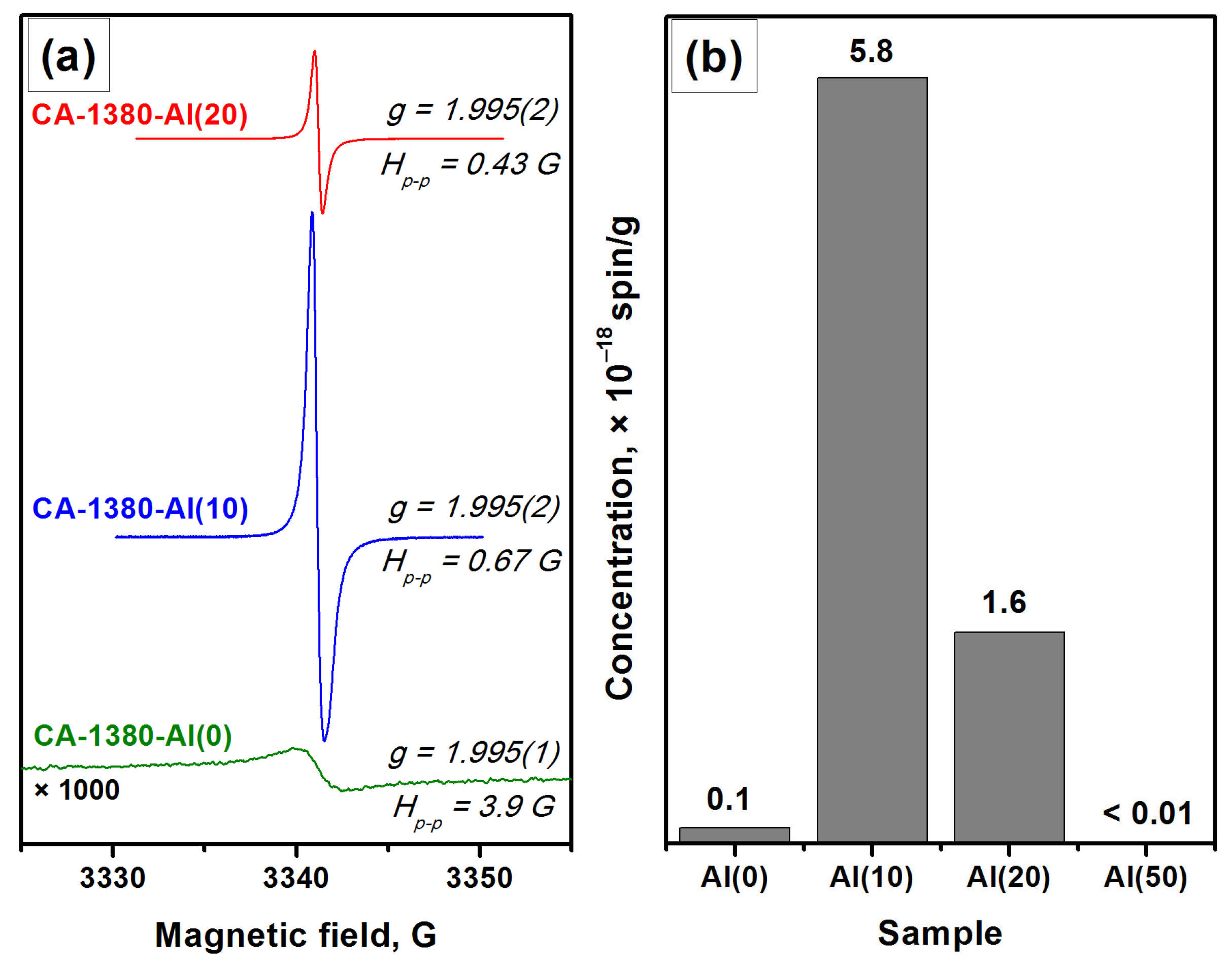Aluminothermic Synthesis of Dispersed Electrides Based on Mayenite: XRD and EPR Study
Abstract
:1. Introduction
2. Materials and Methods
2.1. Synthesis of the Mayenite Samples
2.2. Characterization of the Samples
3. Results and Discussion
3.1. Characterization of the Initial CA-500 Sample
3.2. Characterization of the Samples Calcined at 900 °C
3.3. Characterization of the Samples Calcined at 1150 °C
3.4. Characterization of the Samples Calcined at 1380 °C
4. Conclusions
Supplementary Materials
Author Contributions
Funding
Institutional Review Board Statement
Informed Consent Statement
Data Availability Statement
Acknowledgments
Conflicts of Interest
References
- Matsuishi, S.; Toda, Y.; Miyakawa, M.; Hayashi, K.; Kamiya, T.; Hirano, M.; Tanaka, I.; Hosono, H. High-density electron anions in a nanoporous single crystal: [Ca24Al28O64]4+(4e−). Science 2003, 301, 626–629. [Google Scholar] [CrossRef]
- Hayashi, K.; Matsuishi, S.; Kamiya, T.; Hirano, M.; Hosono, H. Light-induced conversion of an insulating refractory oxide into a persistent electronic conductor. Nature 2002, 419, 462–465. [Google Scholar] [CrossRef]
- Kim, S.W.; Miyakawa, M.; Hayashi, K.; Sakai, T.; Hirano, M.; Hosono, H. Simple and efficient fabrication of room temperature stable electride: Melt-solidification and glass ceramics. J. Am. Chem. Soc. 2005, 127, 1370–1371. [Google Scholar] [CrossRef]
- Zhmoidin, G.I.; Chatterjee, A.K. Conditions and mechanism of interconvertibility of compounds 12CaO·7Al2O3 and 5CaO·3Al2O3. Cement Concrete Res. 1984, 14, 386–396. [Google Scholar] [CrossRef]
- Scrivener, K.L.; Capmas, A. Calcium Aluminate Cements. In Lea’s Chemistry of Cement and Concrete; Elsevier: Amsterdam, The Netherlands, 1998; pp. 713–782. [Google Scholar] [CrossRef]
- Won, J.P.; Hwang, U.J.; Lee, S.J. Enhanced long-term strength and durability of shotcrete with high-strength C12A7 mineral-based accelerator. Cem. Concr. Res. 2015, 76, 121–129. [Google Scholar] [CrossRef]
- Jeevaratnam, J.; Glasser, F.P.; Dent Glasser, L.S. Anion substitution and structure of 12CaO·7Al2O3. J. Am. Ceram. Soc. 1964, 47, 105–106. [Google Scholar] [CrossRef]
- Williams, P.P. Crystal structure of a fluoride derivative of 12CaO·7Al2O3. J. Am. Ceram. Soc. 1968, 51, 531. [Google Scholar] [CrossRef]
- Hosono, H.; Abe, Y. Occurrence of superoxide radical ion in crystalline 12CaO·7Al2O3 prepared via solid-state reactions. Inorg. Chem. 1987, 26, 1192–1195. [Google Scholar] [CrossRef]
- Hayashi, K.; Matsuishi, S.; Hirano, M.; Hosono, H. Formation of oxygen radicals in 12CaO·7Al2O3: Instability of extraframework oxide ions and uptake of oxygen gas. J. Phys. Chem. B 2004, 108, 8920–8925. [Google Scholar] [CrossRef]
- Lacerda, M.; Irvine, J.T.S.; Glasser, F.P.; West, A.R. High oxide ion conductivity in Ca12Al14O33. Nature 1988, 332, 525–526. [Google Scholar] [CrossRef]
- Kim, S.W.; Shimoyama, T.; Hosono, H. Solvated electrons in high-temperature melts and glasses of the room-temperature stable electride Ca24Al28O644+·4e−. Science 2011, 333, 71–74. [Google Scholar] [CrossRef]
- Toda, Y.; Yanagi, H.; Ikenaga, E.; Kim, J.J.; Kobata, M.; Ueda, S.; Kamiya, T.; Hirano, M.; Kobayashi, K.; Hosono, H. Work function of a room-temperature, stable electride [Ca24Al28O64]4+)(e−)4. Adv. Mater. 2007, 19, 3564–3569. [Google Scholar] [CrossRef]
- Boysen, H.; Lerch, M.; Stys, A.; Senyshyn, A. Structure and oxygen mobility in mayenite (Ca12Al14O33): A high-temperature neutron powder diffraction study. Acta Crystallogr. B-Struct. Sci. 2007, 63, 675–682. [Google Scholar] [CrossRef]
- Sushko, P.V.; Shluger, A.L.; Hayashi, K.; Hirano, M.; Hosono, H. Mechanisms of oxygen ion diffusion in a nanoporous complex oxide 12CaO·7Al2O3. Phys. Rev. B 2006, 73, 014101. [Google Scholar] [CrossRef]
- Toda, Y.; Kim, S.W.; Hayashi, K.; Hirano, M.; Kamiya, T.; Hosono, H.; Haraguchi, T.; Yasuda, H. Intense thermal field electron emission from room-temperature stable electride. Appl. Phys. Lett. 2005, 87, 254103. [Google Scholar] [CrossRef]
- Tanaka, I.; Yamanaka, M.; Park, J.K.; Shimomura, T.; Watauchi, S.; Kishio, K. Floating zone growth of calcium aluminate (Ca12Al14O33). J. Ceram. Proc. Res. 2005, 6, 129–133. [Google Scholar]
- Miyakawa, M.; Toda, Y.; Hayashi, K.; Hirano, M.; Kamiya, T.; Matsunami, N.; Hosono, H. Formation of inorganic electride thin films via site-selective extrusion by energetic inert gas ions. J. Appl. Phys. 2005, 97, 023510. [Google Scholar] [CrossRef]
- Matsuishi, S.; Hayashi, K.; Hirano, M.; Hosono, H. Hydride ion as photoelectron donor in microporous crystal. J. Am. Chem. Soc. 2005, 127, 12454–12455. [Google Scholar] [CrossRef]
- Li, J.; Yin, B.; Fuchigami, T.; Inagi, S.; Hosono, H.; Ito, S. Application of 12CaO·7Al2O3 electride as a new electrode for superoxide ion generation and hydroxylation of an arylboronic acid. Electrochem. Commun. 2012, 17, 52–55. [Google Scholar] [CrossRef]
- Salasin, J.R.; Schwerzler, S.E.A.; Mukherjee, R.; Keffer, D.J.; Sickafus, K.E.; Rawn, C.J. Direct formation and structural characterization of electride C12A7. Materials 2019, 12, 84. [Google Scholar] [CrossRef]
- Berent, K.; Komarek, S.; Lach, R.; Pyda, W. The effect of calcination temperature on the structure and performance of nanocrystalline mayenite powders. Materials 2019, 12, 3476. [Google Scholar] [CrossRef] [Green Version]
- Li, J.; Kitano, M.; Ye, T.N.; Sasase, M.; Yokoyama, T.; Hosono, H. Chlorine-tolerant ruthenium catalyst derived using the unique anion-exchange properties of 12CaO·7Al2O3 for ammonia synthesis. ChemCatChem 2017, 9, 3078–3083. [Google Scholar] [CrossRef]
- Hara, M.; Kitano, M.; Hosono, H. Ru-loaded C12A7:e− electride as a catalyst for ammonia synthesis. ACS Catal. 2017, 7, 2313–2324. [Google Scholar] [CrossRef]
- Proto, A.; Cucciniello, R.; Genga, A.; Capacchione, C. A study on the catalytic hydrogenation of aldehydes using mayenite as active support for palladium. Catal. Commun. 2015, 68, 41–45. [Google Scholar] [CrossRef]
- Hayashi, F.; Toda, Y.; Kanie, Y.; Kitano, M.; Inoue, Y.; Yokoyama, T.; Hara, M.; Hosono, H. Ammonia decomposition by ruthenium nanoparticles loaded on inorganic electride C12A7:e−. Chem. Sci. 2013, 4, 3124–3130. [Google Scholar] [CrossRef]
- Kitano, M.; Inoue, Y.; Yamazaki, Y.; Hayashi, F.; Kanbara, S.; Matsuishi, S.; Yokoyama, T.; Kim, S.W.; Hara, M.; Hosono, H. Ammonia synthesis using a stable electride as an electron donor and reversible hydrogen store. Nat. Chem. 2012, 4, 934–940. [Google Scholar] [CrossRef]
- Ye, T.N.; Xiao, Z.; Li, J.; Gong, Y.T.; Abe, H.; Niwa, Y.; Sasase, M.; Kitano, M.; Hosono, H. Stable single platinum atoms trapped in sub-nanometer cavities in 12CaO·7Al2O3 for chemoselective hydrogenation of nitroarenes. Nat. Commun. 2020, 11, 1–10. [Google Scholar] [CrossRef] [Green Version]
- Intiso, A.; Martinez-Triguero, J.; Cucciniello, R.; Proto, A.; Palomares, A.E.; Rossi, F. A novel synthetic route to prepare high surface area mayenite catalyst for TCE oxidation. Catalysts 2019, 9, 27. [Google Scholar] [CrossRef] [Green Version]
- Shuvarakova, E.I.; Ilyina, E.V.; Stoyanovskii, V.O.; Veselov, G.B.; Bedilo, A.F.; Vedyagin, A.A. Exploration of optical, redox, and catalytic properties of vanadia-mayenite nanocomposites. J. Compos. Sci. 2022, 6, 308. [Google Scholar] [CrossRef]
- Shuvarakova, E.I.; Ilyina, E.V.; Cherepanova, S.V.; Gerasimov, E.Y.; Bedilo, A.F.; Vedyagin, A.A. Synthesis of vanadia-mayenite nanocomposites and characterization of their structure, morphology and surface sites. J. Compos. Sci. 2022, 6, 254. [Google Scholar] [CrossRef]
- Kapishnikov, A.V.; Kenzhin, R.M.; Koskin, A.P.; Volodin, A.M.; Geydt, P.V. Mayenite synthesis from hydroxide precursors: Structure formation and active sites on its surface. Materials 2022, 15, 778. [Google Scholar] [CrossRef] [PubMed]
- Intiso, A.; Martinez-Triguero, J.; Cucciniello, R.; Rossi, F.; Palomares, A.E. Influence of the synthesis method on the catalytic activity of mayenite for the oxidation of gas-phase trichloroethylene. Sci. Rep. 2019, 9, 425. [Google Scholar] [CrossRef] [PubMed] [Green Version]
- Ozawa, K.; Sakamoto, N.; Wakiya, N.; Suzuki, H. Fabrication of 12CaO·7Al2O3 powders with high specific surface area by sol-gel and ball-milling method. J. Ceram. Soc. Jpn. 2011, 119, 460–463. [Google Scholar] [CrossRef] [Green Version]
- Li, C.S.; Hirabayashi, D.; Suzuki, K. Synthesis of higher surface area mayenite by hydrothermal method. Mater. Res. Bull. 2011, 46, 1307–1310. [Google Scholar] [CrossRef]
- Matsuishi, S.; Nomura, T.; Hirano, M.; Kodama, K.; Shamoto, S.; Hosono, H. Direct synthesis of powdery inorganic electride Ca24Al28O644+ (e−)4 and determination of oxygen stoichiometry. Chem. Mater. 2009, 21, 2589–2591. [Google Scholar] [CrossRef]
- Mercury, J.M.R.; De Aza, A.H.; Pena, P. Synthesis of CaAl2O4 from powders: Particle size effect. J. Eur. Ceram. Soc. 2005, 25, 3269–3279. [Google Scholar] [CrossRef]
- Hayashi, K.; Hirano, M.; Matsuishi, S.; Hosono, H. Microporous crystal 12CaO·7Al2O3 encaging abundant O− radicals. J. Am. Chem. Soc. 2002, 124, 738–739. [Google Scholar] [CrossRef]
- Ilyina, E.V.; Bedilo, A.F.; Cherepanova, S.V.; Gerus, Y.Y.; Shuvarakova, E.I.; Vedyagin, A.A. Aerogel synthesis of calcium aluminates with varied stoichiometry. J. Sol.-Gel Sci. Technol. 2022, 104, 259–266. [Google Scholar] [CrossRef]
- Li, F.; Zhang, X.; Liu, H.L. Calciothermic synthesis of inorganic Ca24Al28O644+(4e−) electride from solid-derived precursor. Vacuum 2019, 169, 108880. [Google Scholar] [CrossRef]
- Li, F.; Zhang, X.; Liu, H.L. Insights into the direct formation of Ca24Al28O644+(4e−) and its electrical characterization. J. Am. Ceram. Soc. 2020, 103, 35–42. [Google Scholar] [CrossRef]
- Li, F.; Zhang, X.; Zhang, J.X. Aluminothermic synthesis of Ca24Al28O644+·(4e−) electride ceramic directly from Ca3Al2O6 precursor. Vacuum 2019, 167, 352–356. [Google Scholar] [CrossRef]
- Jiang, D.; Zhao, Z.Y.; Mu, S.L.; Qian, H.J.; Tong, J.H. Facile and massive aluminothermic synthesis of mayenite electrides from cost-effective oxide and metal precursors. Inorg. Chem. 2019, 58, 960–967. [Google Scholar] [CrossRef]
- Bedilo, A.F.; Shuvarakova, E.I.; Volodin, A.M. Silica-coated nanocrystalline TiO2 with improved thermal stability. Ceram. Int. 2019, 45, 3547–3553. [Google Scholar] [CrossRef]
- Zaikovskii, V.I.; Volodin, A.M.; Stoyanovskii, V.O.; Cherepanova, S.V.; Vedyagin, A.A. Effect of carbon coating on spontaneous C12A7 whisker formation. Appl. Surf. Sci. 2018, 444, 336–338. [Google Scholar] [CrossRef]
- Yakovlev, I.V.; Volodin, A.M.; Papulovskiy, E.S.; Andreev, A.S.; Lapina, O.B. Structure of carbon-coated C12A7 electride via solid-state NMR and DFT calculations. J. Phys. Chem. C 2017, 121, 22268–22273. [Google Scholar] [CrossRef]
- Volodin, A.M.; Zaikovskii, V.I.; Kenzhin, R.M.; Bedilo, A.F.; Mishakov, I.V.; Vedyagin, A.A. Synthesis of nanocrystalline calcium aluminate C12A7 under carbon nanoreactor conditions. Mater. Lett. 2017, 189, 210–212. [Google Scholar] [CrossRef]
- Rybak, A.A.; Yushkov, I.D.; Nikolaev, N.A.; Kapishnikov, A.V.; Volodin, A.M.; Krivyakin, G.K.; Kamaev, G.N.; Geydt, P.V. Electrophysical properties of polycrystalline C12A7:e− electride. Electronics 2022, 11, 668. [Google Scholar] [CrossRef]
- Toby, B.H.; Von Dreele, R.B. GSAS-II: The genesis of a modern open-source all purpose crystallography software package. J. Appl. Crystallogr. 2013, 46, 544–549. [Google Scholar] [CrossRef]






| Sample | Phase Composition | a, Å | SSA, m2∙g−1 |
|---|---|---|---|
| CA-900-Al(0) | C12A7 (77%) + CaO (23%) | 11.967 | 26 |
| CA-900-Al(10) | C12A7 (95%) + CaO (4%) + Al (1%) | 11.989 | 18 |
| CA-900-Al(20) | C12A7 (87%) + CaO (5%) + Al (8%) | 12.001 | 18 |
| Sample | Phase Composition | a, Å | SSA, m2∙g−1 |
|---|---|---|---|
| CA-1150-Al(0) | Ca3Al2O6 (52%) + C12A7 (24%) + CaAl2O4 (24%) | 11.984 | 12 |
| CA-1150-Al(10) | Ca3Al2O6 (24%) + C12A7 (25%) + CaAl2O4 (23%) + Ca5Al6O14 (26%) + Al (2%) | 11.999 | 20 |
| CA-1150-Al(20) | C12A7 (72%) + Ca3Al2O6 (5%) + CaAl2O4 (15%) + Ca2Al2O5 (5%) + Al (3%) | 12.031 | 10 |
| CA-1150-Al(20)-O2 | C12A7 (41%) + Al2O3 (9%) + CaAl2O4 (12%) + Ca3Al2O6 (8%) + Al (30%) | 11.996 | 4.8 |
| CA-1150-Al(50) | C12A7 + Al2O3 + CaAl4O7 + CaAl2O4 + Al | 11.981 | 4 |
| Sample | Phase Composition | a, Å | SSA, m2∙g−1 |
|---|---|---|---|
| CA-1380-Al(0) | C12A7 (93%) + Ca3Al2O6 (7%) | 11.991 | <1 |
| CA-1380-Al(10) | CaAl2O4 (64%) + C12A7 (30%) + Ca2Al2O5 (6%) | 12.025 | 4.4 |
| CA-1380-Al(20) | C12A7 + CaAl2O4 + Al2O3 + Ca3Al10O18 + CaAl4O7 + CaAl1.9O4C0.4 | 11.989 | - |
| CA-1380-Al(50) | CaAl1.9O4C0.4 + CaAl4O7 + Al2O2C + Al | - | 6.5 |
Publisher’s Note: MDPI stays neutral with regard to jurisdictional claims in published maps and institutional affiliations. |
© 2022 by the authors. Licensee MDPI, Basel, Switzerland. This article is an open access article distributed under the terms and conditions of the Creative Commons Attribution (CC BY) license (https://creativecommons.org/licenses/by/4.0/).
Share and Cite
Volodin, A.M.; Kenzhin, R.M.; Kapishnikov, A.V.; Komarovskikh, A.Y.; Vedyagin, A.A. Aluminothermic Synthesis of Dispersed Electrides Based on Mayenite: XRD and EPR Study. Materials 2022, 15, 8988. https://doi.org/10.3390/ma15248988
Volodin AM, Kenzhin RM, Kapishnikov AV, Komarovskikh AY, Vedyagin AA. Aluminothermic Synthesis of Dispersed Electrides Based on Mayenite: XRD and EPR Study. Materials. 2022; 15(24):8988. https://doi.org/10.3390/ma15248988
Chicago/Turabian StyleVolodin, Alexander M., Roman M. Kenzhin, Aleksandr V. Kapishnikov, Andrey Y. Komarovskikh, and Aleksey A. Vedyagin. 2022. "Aluminothermic Synthesis of Dispersed Electrides Based on Mayenite: XRD and EPR Study" Materials 15, no. 24: 8988. https://doi.org/10.3390/ma15248988






